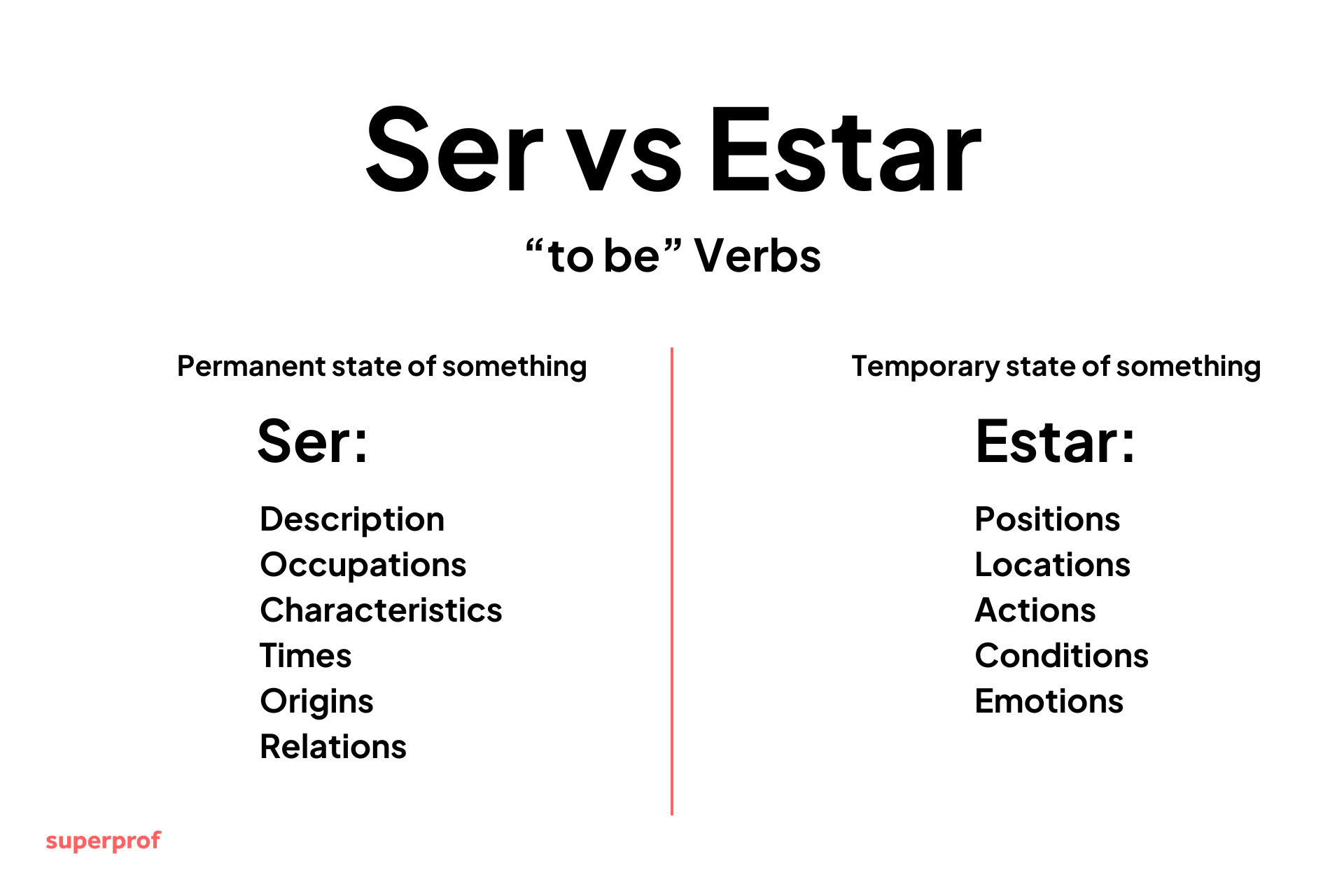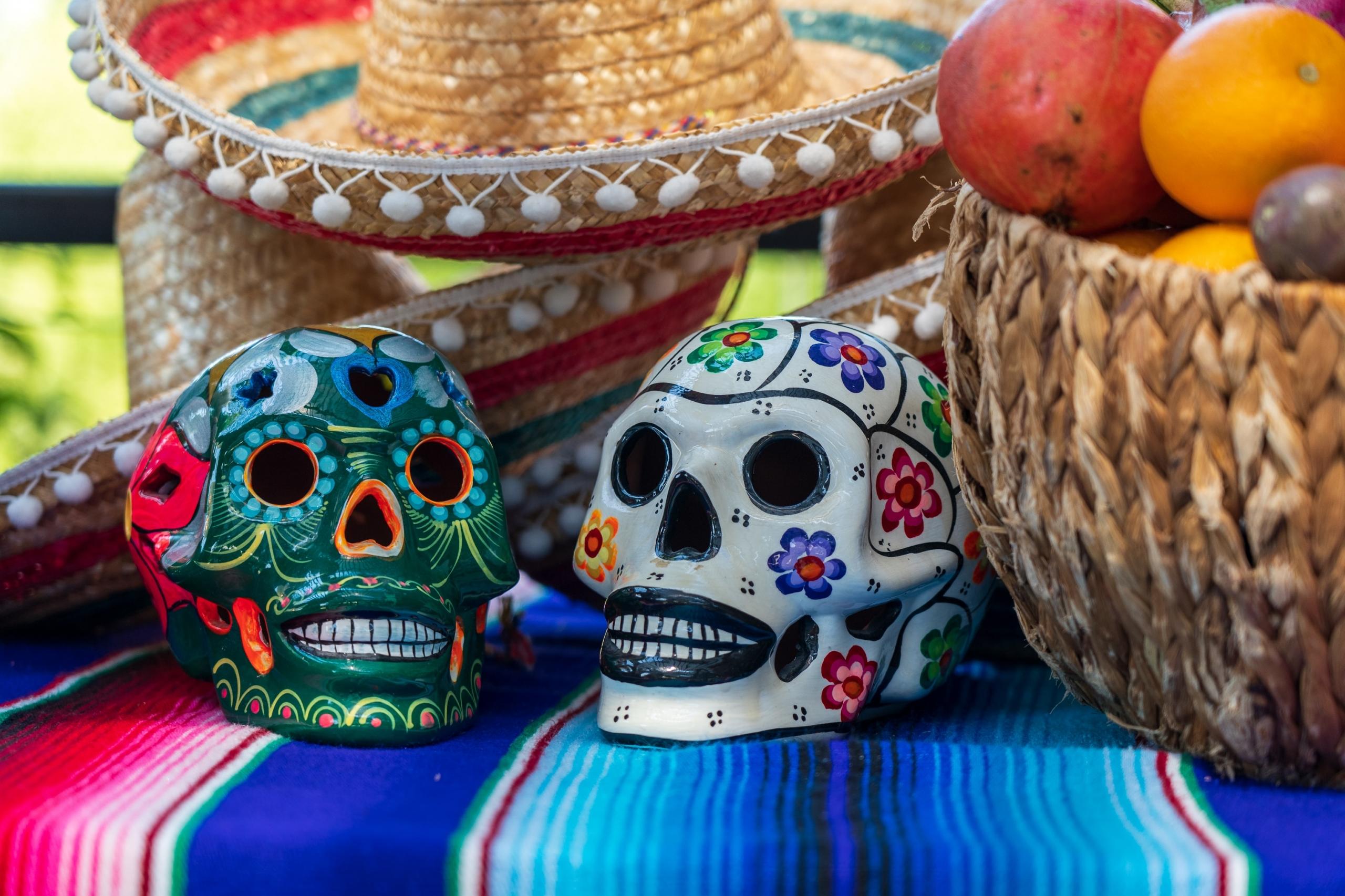If you're studying Spanish, the verbs (that's plural) for "to be" will be your first real challenge. In Spanish, "ser" and "estar" are both translated to "to be" in English, but they describe different ideas. You have to learn how to use both, as using the wrong one can greatly change the meaning of sentences. Let's learn how they work, how to conjugate them in the present tense, and remember which one to use.


What Are Ser and Estar?
Ser and estar are the Spanish verbs that translate to the English verb "to be", but the one you must use depends on the situation. This can be confusing for English speakers because you have to think a little more than you usually would when simply using "to be".
The key difference between these two verbs is that ser is used for more permanent qualities while estar is used for temporary conditions. However, you'll also see that, as with English and other languages, specific nuances and exceptions make it all a little more confusing.
- Generally, ser refers to identity, characteristics, origin, time, and other permanent states.
- Estar will be used to talk about location, emotions, physical states, and other temporary conditions.
To simplify it, you could imagine using ser with “always” and estar with “right now”, at least when speaking in the present tense.
| Verb | Used For | Example Sentence | Translation |
|---|---|---|---|
| Ser | Permanent traits, identity, time, origin | Ella es doctora. | She is a doctor. |
| Estar | Temporary states, emotions, location | Ella está feliz hoy. | She is happy today. |
How to Remember: DOCTOR vs PLACE
A great way to remember how to use ser and estar (at least until you get the hang of them) is by using the acronyms DOCTOR and PLACE.
DOCTOR stands for Description, Occupation, Characteristic, Time/Date, Origin, and Relationship. If any of these apply, use ser.
Here's how it's used.
| Letter | Stands For | Example |
|---|---|---|
| D | Description | El cielo es azul. (The sky is blue.) |
| O | Occupation | Soy maestro. (I am a teacher.) |
| C | Characteristic | Ella es simpática. (She is nice.) |
| T | Time/Date | Son las dos. (It’s two o’clock.) |
| O | Origin | Soy de México. (I am from Mexico.) |
| R | Relationship | Ellos son hermanos. (They are brothers.) |
PLACE stands for Position, Location, Action (progressive), Condition, Emotion. In these instances, use estar.
| Letter | Stands For | Example |
|---|---|---|
| P | Position | El libro está sobre la mesa. (The book is on the table.) |
| L | Location | Estoy en casa. (I am at home.) |
| A | Action (progressive) | Estamos estudiando. (We are studying.) |
| C | Condition | Estás cansado. (You are tired.) |
| E | Emotion | Ella está feliz. (She is happy.) |
Naturally, you won't be able to go through these every time you speak, but as you learn the difference between ser and estar, these acronyms can be very helpful.

Present Tense Conjugations: Ser and Estar
Hopefully, you didn't think you were done with ser and estar just because you know when to use them. To use either of these verbs in the present tense, you will have to conjugate them.
Conjugations are a common irritation for English speakers when they first learn other languages. English has so few of them, while languages like Spanish have many.
The verb "to be" in English is irregular, so it's one of the English verbs with more conjugations.
Here are the six grammatical pronouns we use in English. They include first-, second-, and third-person pronouns in singular and plural forms.
First-person is when the speaker refers to themselves, second-person refers to the listener, and third-person is when they talk about something else, literally a third-person (who isn't privy to the conversation).
Spanish uses the same pronouns, too, which means you have six distinct pronoun types to remember. Since each has a singular and plural form.
However, because of the gendered nouns in Spanish, there are more than six to remember, but when it comes to conjugating, you only have six conjugations per grammatical tense.
The six Spanish pronouns are:
- First-person (singular) - Yo
- Second person (singular) - Tú
- Third person (singular) - Él / Ella / Usted
- First-person (plural) - Nosotros/as
- Second person (plural) - Vosotros/as
- Third person (plural) - Ellos / Ellas / Ustedes
To conjugate, you take the pronoun and then add the appropriate conjugation (version) of the verb that matches.
Here's how that looks in the case of ser in the present tense (with examples).
| Pronoun | Conjugation | Example Sentence |
|---|---|---|
| Yo | soy | Yo soy estudiante. (I am a student.) |
| Tú | eres | Tú eres muy amable. (You are very kind.) |
| Él / Ella / Usted | es | Ella es doctora. (She is a doctor.) |
| Nosotros/as | somos | Somos amigos. (We are friends.) |
| Vosotros/as | sois (Spain) | Vosotros sois felices. (You all are happy.) |
| Ellos / Ellas / Ustedes | son | Ellos son hermanos. (They are siblings.) |
The same can be done with estar and it works exactly in the same way.
| Pronoun | Conjugation | Example Sentence |
|---|---|---|
| Yo | estoy | Estoy en casa. (I am at home.) |
| Tú | estás | ¿Estás bien? (Are you okay?) |
| Él / Ella / Usted | está | Ella está feliz. (She is happy.) |
| Nosotros/as | estamos | Estamos ocupados. (We are busy.) |
| Vosotros/as | estáis (Spain) | ¿Dónde estáis? (Where are you all?) |
| Ellos / Ellas / Ustedes | están | Ellos están en la escuela. (They are at school.) |
Pay attention to the forms soy and estoy. Both mean “I am,” but they tell very different stories in a sentence. That’s why context is everything when choosing the right verb.
When to Use Ser: Permanent States and Characteristics
Don't forget the DOCTOR acronym. That's when you should use ser.
Ser is used to describe things that are usually unchanging, inherent, or part of somebody's identity. Consider these permanent qualities or what makes someone or something who they are. This can include their professions, physical characteristics, or even relationships.

Let's see some more examples to give you a better idea.
La casa es grande. → The house is big.
Mi padre es ingeniero. → My father is an engineer.
Soy alto y simpático. → I am tall and nice.
Son las tres de la tarde. → It's 3 PM.
Somos de Colombia. → We are from Colombia.
Ella es mi hermana. → She is my sister.
Think of ser like a camera snapshot. It describes the essential traits of a person, place, or thing. You’re not talking about how they feel right now, but rather what they are.

When to Use Estar: Temporary Conditions and Location
Estar is about temporary states, feelings, locations, and conditions. It refers to things that can change. Again, remember the acronym PLACE and consider these examples to give you a better idea.
El cuaderno está debajo de la mesa. → The notebook is under the table.
Estamos en la escuela. → We are at school.
Estoy estudiando español. → I'm studying Spanish.
Estás enfermo hoy. → You're sick today.
Ella está feliz ahora. → She is happy right now.
Common Mistakes and How to Avoid Them
Don't worry about making mistakes with ser and estar, it happens all the time when people learn Spanish. Either mistake will rarely offend anyone, and most people will know that you're not a native speaker and will make these kinds of mistakes. Mostly, they're funny mistakes, and you can laugh them off and correct them yourself.
With that in mind, here are some of the most common mistakes when choosing between ser and estar.
❌ Mistake #1: Using ser for emotions
- Wrong: Soy feliz hoy.
- Right: Estoy feliz hoy.
❌ Mistake #2: Using estar for time
- Wrong: Está la una.
- Right: Es la una.
❌ Mistake #3: Mixing up location with origin
- Wrong: Estamos de México.
- Right: Somos de México.
❌ Mistake #4: Describing someone's personality with estar
- Wrong: Él está simpático.
- Right: Él es simpático.
Ask yourself: Is this something that can change quickly? If the answer is yes, use estar. If not, ser is probably the verb you need.

Practice Makes Perfect: Try It Yourself
The best way to get the hang of ser and estar is by simply practicing Spanish. The more you speak Spanish and use these verbs, the more you'll naturally understand how they're used.
- Yo ______ cansado.
- Ellos ______ de España.
- Ella ______ profesora.
- Nosotros ______ en casa.
- ¿Tú ______ feliz hoy?
Answers
- estoy
- son
- es
- estamos
- estás
Now, try it for yourself. Create your own sentences. Try writing three sentences using ser and three using estar (using different conjugations).
- A person’s personality or job
- Where someone is right now
- How you feel today
- The time
- Where an object is
- A physical condition or emotion
Need a refresher? Watch this video.
Quick Reference Chart: Ser vs Estar Cheat Sheet
Here's a useful table including ser and estar to help you remember how they are used. Feel free to print it out, though we recommend writing it out yourself by hand, as this will help you remember it. If you're creative, you can even decorate it with drawings of the example sentences or create your own.
| Category | Ser | Estar |
|---|---|---|
| Meaning | To be (essential/permanent) | To be (temporary/state) |
| Conjugation (yo) | soy | estoy |
| Used For | Description, origin, time, identity | Location, emotion, condition, position |
| Keyword Acronym | DOCTOR | PLACE |
| Example 1 | Ella es alta. (She is tall.) | Ella está cansada. (She is tired.) |
| Example 2 | Son las ocho. (It’s eight o’clock.) | Estamos en casa. (We are at home.) |
| Example 3 | Soy de México. (I am from Mexico.) | Estoy feliz hoy. (I’m happy today.) |
| Type of State | Permanent / Defining | Temporary / Changing |
Tip to Remember: Ser is about what something is. Estar is about how it is — especially in the moment.
Where You’ll Go Next: Dive Deeper into Ser and Estar
Now that you have a better idea of ser and estar in the present tense, you can dive further into Spanish grammar.
You don't even need to move on to different verbs, as there's plenty more to learn about ser and estar, like:
- Ser and estar in the preterite tense (past)
- Common expressions and idioms using both verbs
- Advanced uses, including compound tenses
- Cultural nuances in how ser and estar are used across Spanish-speaking countries

As with everything, practice makes perfect. The more you use these, the more you'll understand them.
If you're looking for ways to practice and improve your Spanish, you could also enlist the help of a private tutor. Just search for Spanish on the Superprof website!
























